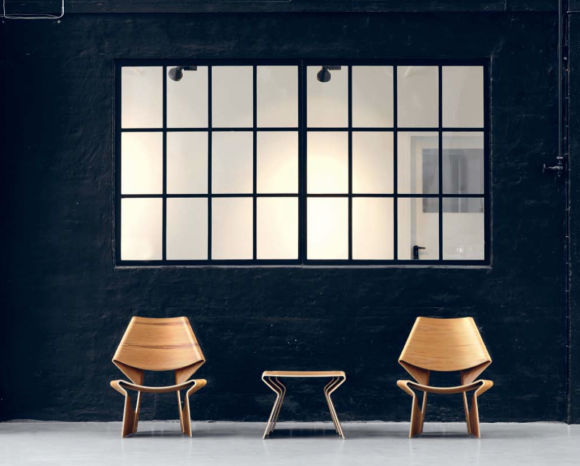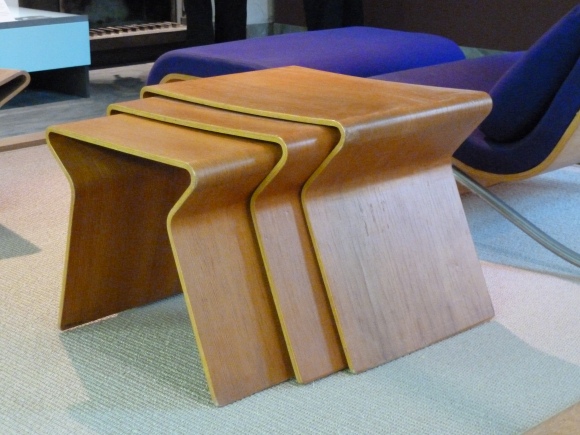 Grete Juel Jalk (1920–2006) was a Danish furniture designer. From the 1960s, she did much to enhance Denmark’s reputation for modern furniture design with her clear, comfortable lines. She also edited the Danish magazine Mobilia and compiled a four-volume work on Danish furniture.
Grete Juel Jalk (1920–2006) was a Danish furniture designer. From the 1960s, she did much to enhance Denmark’s reputation for modern furniture design with her clear, comfortable lines. She also edited the Danish magazine Mobilia and compiled a four-volume work on Danish furniture.
After graduating from high school in modern languages and philosophy, she studied at the Design School for Women (1940–43) under cabinetmaker Karen Margrethe Conradsen. She completed her studies at the Danish Design School in 1946, while receiving additional instruction from Kaare Klint at the Royal Academy’s Furniture School. While consolidating contacts with numerous furniture designers, she took part in the annual competitions of the Design Museum and the Design School’s furniture department where she also taught from 1950 to 1960.
In 1953, Jalk opened her own design studio. Side by side with these rather advanced experiments, Jalk developed many simple sets of furniture for manufacturers, including a high desk and stool, a set of shelves in Oregon pine and a series of chairs with upholstered seats and backs on a curved steel base. Her industrially produced furniture has clear, comfortable lines. The pieces are especially well suited for quick, straightforward production schedules. Economic in their use of materials, they soon became competitive, increasing Denmark’s international reputation for furniture design. Firms in the United States and Finland have manufactured some of her lines. The designs she developed for modern homes included a wall-mounted storage system (1961), a living-room set with a coffee table (1962), a “Watch and Listen” unit (1963) with compartments for a home entertainment system to house a stereo system, TV, records, tapes and speakers. Jalk also designed wallpaper and upholstery, for example for Unika Væv, and silverware for Georg Jensen.
Jalk contributed enthusiastically to literature on Danish furniture. Together with Gunnar Bratvold she edited the furniture and interior design magazine Mobilia from 1956 to 1962 and again after Fratvold’s death from 1968 to 1974. This led to a four-volume work, considered to be one of the most comprehensive in the field. For more info look for: Grete Jalk, Dansk møbelkunst gennem 40 år – 40 years of Danish furniture design, 1987, Tåstrup: Teknologisk Instituts Forlag, 4 volumes: ISBN 87-7511-711-8, ISBN 87-7511-712-6, ISBN 87-7511-713-4 and ISBN 87-7511-714-2.
PLYWOOD GJ CHAIR & TABLE
Due to the complexity of the chair’s design, only around 300 copies were originally produced. Only a few remain in existence today. Inspired by Alvar Aalto’s laminated bent-plywood furniture and Charles Eames’ moulded plywood designs, she began to develop her own boldly curved models. General interest in her unconventional models grew only slowly although they were sought after for exhibitions and collections. In 1963, the English newspaper Daily Mail launched a competition for a chair for a man and a chair for a woman. Despite the fact that Jalk won first prize with two different laminated armchairs, the He Chair and the She Chair, they never really came into production. Her associate, cabinetmaker and furniture manufacturer Poul Jeppesen, had made some prototypes but they were burnt in a fire, bringing the project to an end. In 2008, however, Lange Production began industrial production of the She Chair.
Designed by Grete Jalk (1920-2006) in 1963, the Laminated Chair is regarded today as the Danish designer’s best-known work. The chair, for which Jalk also created a companion side table, was realised in collaboration with the cabinetmaker Poul Jeppesen. Although it won first prize in a competition organised by the British newspaper Daily Mail during the year of its inception, the chair never went into industrial production.
Only a few original examples of this chair exist to day from the 300 limit production batch. This explains the extremely high prices that have been paid for this model at international auctions in recent years that exced $10,000. The expressive sculptural form of the chair, composed of two similarly shaped pieces of moulded plywood, marks a late highlight in the engagement of prominent designers with this material, which had commenced in the 1930s.
GLOSTRUP MOEBELFABRIK LOUNGE ARMCHAIR
Below are images of Grete Jalk’s Classic lounge armchair by Grete Jalk for Glostrup Moebelfabrik from the 1960s; a delicate teakwood frame with beautiful curved armrests.
One notable aspect of the classic lounge armchair and quality chairs of the time is that it has The Danish Furnituremakers Quality Control stamp, a A guarantee of high quality. The Danish Furnituremakers Quality Control is an association of leading Danish furniture manufacturers. Its objective is to guarantee consumers and retailers a perfect product and a level of quality, which fulfils the strict requirements for material and workmanship, laid down in the articles of the association.
The Department of Wood Technology at the Technological Institute ensures that the requirements for materials and workmanship are observed – partly by unannounced visits to member factories and partly by testing of randomly chosen furniture. Because of this, the Danish Furnituremakers Quality Control label has become a guarantee, both for the consumer and for the retailer, and an assurance that the furniture will be able to live up to all reasonable expectations.
————————
TEXT SOURCES
wikipedia.com
collectionofdesign.com
deconet.com

















